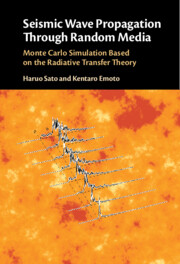 Seismic Wave Propagation Through Random Media
Seismic Wave Propagation Through Random Media Published online by Cambridge University Press: 31 October 2024
Chapter 6 studies vector wave scattering in random elastic media. The Born approximation leads to PP, PS, SP, and SS scattering coefficients, from each of which we construct the corresponding PRNG of scattering angles. Using these in MC simulations, we synthesize three-component RMS velocity amplitude time traces for the radiation from a point shear dislocation (PSD) source. The simulation results are compared with the ensemble average of FD simulation results in random elastic media for a given power spectral density function.
To save this book to your Kindle, first ensure [email protected] is added to your Approved Personal Document E-mail List under your Personal Document Settings on the Manage Your Content and Devices page of your Amazon account. Then enter the ‘name’ part of your Kindle email address below. Find out more about saving to your Kindle.
Note you can select to save to either the @free.kindle.com or @kindle.com variations. ‘@free.kindle.com’ emails are free but can only be saved to your device when it is connected to wi-fi. ‘@kindle.com’ emails can be delivered even when you are not connected to wi-fi, but note that service fees apply.
Find out more about the Kindle Personal Document Service.
To save content items to your account, please confirm that you agree to abide by our usage policies. If this is the first time you use this feature, you will be asked to authorise Cambridge Core to connect with your account. Find out more about saving content to Dropbox.
To save content items to your account, please confirm that you agree to abide by our usage policies. If this is the first time you use this feature, you will be asked to authorise Cambridge Core to connect with your account. Find out more about saving content to Google Drive.